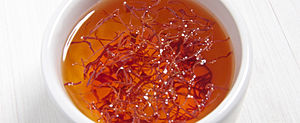Translations:Saffron/43/en
Consumption

Saffron's aroma is often described by connoisseurs as reminiscent of metallic honey with grassy or hay-like notes, while its taste has also been noted as hay-like and sweet. Saffron also contributes a luminous yellow-orange colouring to foods. Saffron is widely used in Persian, Indian, European, and Arab cuisines. Confectioneries and liquors also often include saffron. Saffron is used in dishes ranging from the jewelled rice and khoresh of Iran, the Milanese risotto of Italy, the paella of Spain, the bouillabaisse of France, to the biryani with various meat accompaniments in South Asia. Saffron is also used in the preparation of the Golden Ham, a precious dry-cured ham made with saffron from San Gimignano in Tuscany. Common saffron substitutes include safflower (Carthamus tinctorius, which is often sold as "Portuguese saffron" or "açafrão"), annatto, and turmeric (Curcuma longa). In Medieval Europe, turmeric was also known as "Indian saffron" because of its yellow-orange colour.